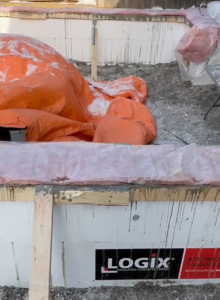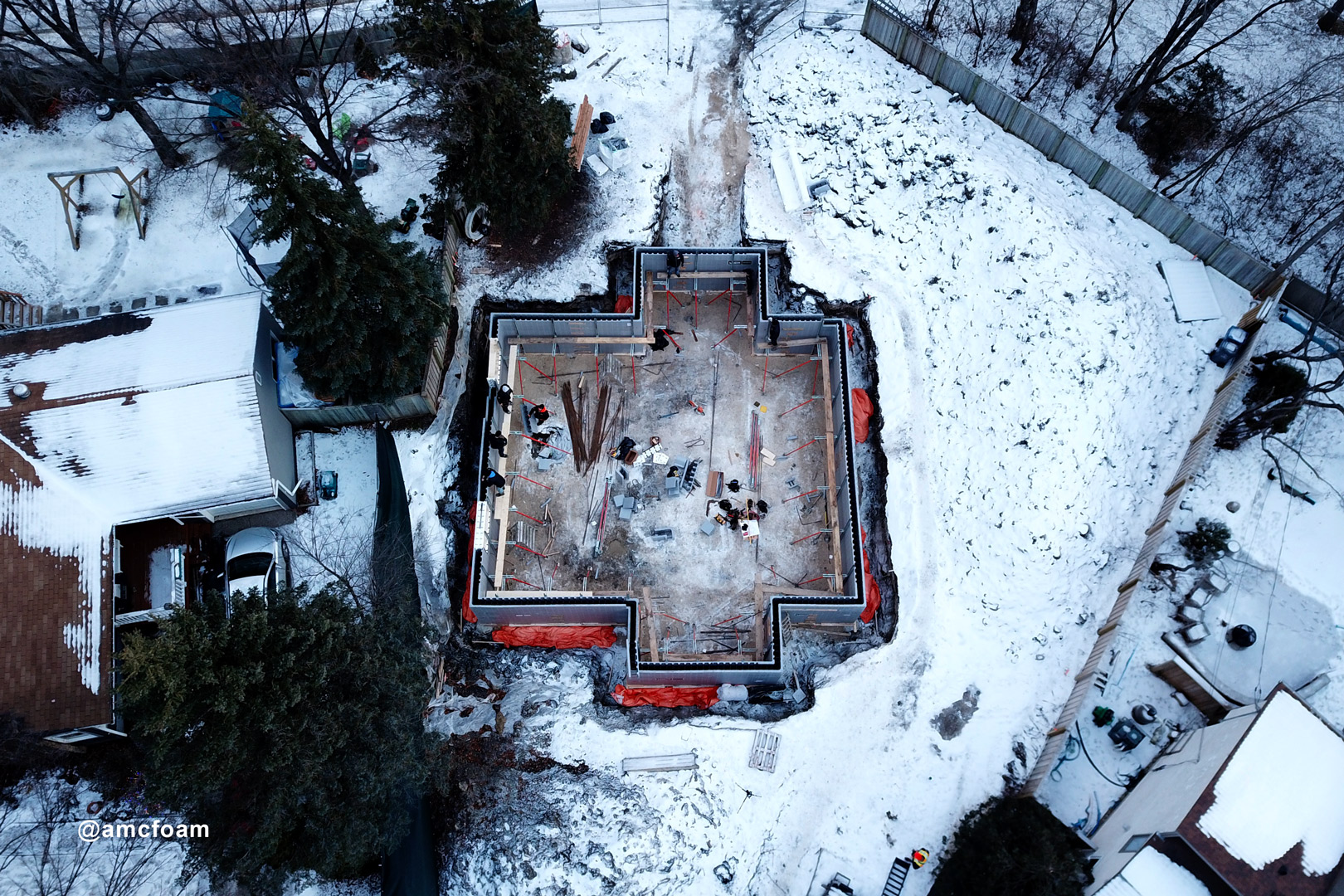Pouring concrete in frigid weather seems like a dreadful task, but if you’re building with ICFs, don’t fret — you have it much easier than the guy pouring slabs or stairs. Your ICF walls give you a huge advantage in cold weather because they sandwich the freshly poured concrete between two layers of insulation and protect it from the hostile weather.
But there are still things you can do to ensure your winter concrete pour goes off without a hitch — even with the added protection of the ICFs. In the post below, you’ll learn three simple strategies for pouring ICF concrete cores smoothly in subzero temperatures:
- Ensure proper concrete curing
- Discharge the concrete quickly
- Use admixtures to accelerate curing
We’ve got the details below, so read on to find out more.
1. Ensure Proper Curing Temperature at the Top of the Wall
The top of an ICF wall is the concrete core’s weakest part in cold weather, and you must take care to protect it if you want the concrete to cure properly.
Here’s why.
When pouring concrete in freezing temperatures, you have to ensure that the mix maintains a specific ambient temperature to cure correctly. Per the standard, a regular concrete mix requires a minimum ambient temperature of 10°C (50°F) over a 3-day period, or until reaching 40% of the design strength. Of course, the ICFs shield the fresh mix from both sides, which means that the heat generated during hydration does not dissipate. Generally, freshly poured ICF cores can maintain the required 10°C (50°F) without problems when the outdoor temps plunge below freezing.
That said, there’s one part of the core that remains critically exposed to the cold — the top of the wall. At the top of the core, there’s no ICF panels to shield the concrete mix from the weather, and the heat produced by hydrations has an easy means of escape. This lack of protection means the cold can derail the curing process in the top portion of the ICF wall. For this reason, you should always cover the top of the ICF wall and protect that band of concrete from the chilly temps — no matter how narrow the core is.
How to Ensure Proper Curing Temps At the Top of ICF Walls

Example of insulation on the top of ICF walls after concrete pour.
There are two ways you can protect the freshly poured mixture at the top of the concrete wall:
- Use thermal blankets: Thermal blankets offer a quick and easy way to shield the exposed concrete at the top of the ICF core from the cold air and prevent heat loss. However, thermal blankets must have a high enough R-Value to be effective.
- Use foam board insulation: Foam board insulation, such as Halo’s Subterra, offers R-Values of R-5 per nominal inch. That’s sufficiently high to prevent heat loss at the top of the ICF wall and keep the curing process on track.
Conversely, there is something you shouldn’t use to keep the top of ICF cores warm — straw. Straw has limited insulative value compared to thermal blankets and foam board insulation, so you risk compromising the curing process at the top of the wall by allowing the heat to escape.
2. Discharge the Concrete As Fast As Possible
When pouring in freezing temperatures, you want your mix to start curing as soon as possible. To this end, you must fill the ICF wall cavities with the concrete mix soon after the truck leaves the plant. While the CSA allows for a maximum discharge time of 2 hours, that’s far too long of a wait on extremely cold days — the concrete temperature will drop too low in that time.
When the plant sends the mix to your site, they’ll generally have it at the minimum 10°C (50°F). On chilly days, they’ll heat the aggregate or the water and get the mix up to 20°C (68°F) — that’s just warm enough for you to discharge the concrete before its temperatures slide below the minimum. However, you must still act quickly and get it poured into the safety of the insulated ICF cavities. The absolute last thing you want is for the concrete to dip to its freezing point, which is -5°C (23°F).
3. Use the Admixtures to Accelerate Curing
Certain admixtures can speed up the concrete curing process, and you should ask your plant for these when pouring on extremely cold days. However, some of these admixtures are incompatible with the rebar in ICF walls, so you should always request the non-chloride versions.
Also, note that mixtures that accelerate curing should never be added on site — the ready mix plant should add them for you.
Wrapping It Up
If you’re pouring ICF concrete cores on a particularly chilly day, the ICFs themselves will do most of the work of keeping the curing temperatures above the required minimum. However, you can ensure a seamless pour and uninterrupted curing process by following the three tips we discussed above:
- Shield the tops of ICF walls with a thermal blanket or rigid insulation
- Discharge the concrete as soon as possible
- Use admixtures to help the concrete cure faster
Content provided by: Andy Lennox, President at Logix Brands Inc












